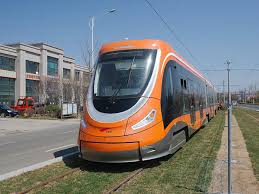China’s Hydrogen Tram
by Keith D. Foote
As part of the China’s efforts to deal with their massive pollution problems, they have launched the world’s first hydrogen-powered tramcar. This cutting edge, environmentally friendly transport system was developed by the China South Rail, and came the from factories in eastern Shandong Province of China. The tram’s tanks can be filled with hydrogen in three minutes and can carry it 62 kilometers. It should be able of run at speeds up to 100 kilometers per hour. It comes with 60 seats, and is described as being capable of carrying over 380 passengers.
With the help of research institutions, it took two took two years to solve key technological problems, Chinese officials have stated. The running costs will be reduced significantly with the new tram system. Hydrogen fuel cells are being developed for China’s auto industry, but this is the first hydrogen-powered train.
According to Chinese officials, nitrogen oxides will not be released as pollution. The temperature inside of the fuel cell is controlled, and does not exceed 100°C, meaning nitrogen oxides do not form, and water is the only emission released. This kind of system is necessary to help China’s smog choked atmosphere, which pollutes the world’s atmosphere.
The most obvious problem with the current situation is China has only 83 miles of tracks for the tram system, which is laid out in just seven cities. There are, however, reasons for optimism. The Chinese government has to big plans for the hydrogen-powered tram technology. They are planning to spend over 200 billion yuan (or $32 billion) during the next 5 years to increase the amount of tram tracks by more than ten, raising it to 1,200 miles. According to the Xinhua state news, they also plan to buy more trams.
Foshan, a city with 8 million people, is scheduled to adopter one later this year. Foshan has plans for getting very heavily involved in new hydrogen transit industry. Last year, Foshan invested $72 million in plans to build the trams locally, with nationwide distribution as the goal. There are also plans to organize a Chinese hydrogen-power research and testing center.
The city’s commitment to using clean energy seems to go well beyond hydrogen. An article in the Foshan Daily has said the city is also going to work with SAIC Motor, which is China’s largest automaker. They would like to produce parts for cars using hydrogen-cells. However, an SAIC spokesperson would not comment on the report, and any joint efforts on hydrogen-cell cars may still be in the dream stage. Last year, SAIC said it was moving to advance electric and hybrid autos. Hydrogen-cell autos are still in the research and testing phase.
At present, Toyota is the only auto manufacturer to develop a hydrogen car, called the Mirai, which should go on sale in America later this year. Toyota’s research in hydrogen as a fuel far exceeds anything their Chinese counterparts have achieved, according to Xu Sichuan, who is a professor at the Tongji University.
With wind and solar energy growing faster and faster and with electric vehicles increasing in popularity, many people in the United States may have never heard of the promised hydrogen economy. However, in research labs all around the world, research and progress has continued. At present, scientists are saying a new process could help us achieve a sustainable hydrogen-based energy industry.
A major challenge facing researchers is creating affordable hydrogen fuel cells has been the storage issue. Hydrogen is very explosive and requires very expensive containers to store it safely. Recently, researchers have shown formic acid may be a good material for storing hydrogen. It is described as a common industrial chemical, and is also used as an ant venom, and is inexpensive and stable. A single molecule of this acid is made up of five atoms, with two being hydrogen atoms. However, breaking down the formic acid to release the hydrogen, in turn producing electricity, takes quite a bit of heat during the processing.
With this problem in mind, the researchers have developed a simple method for producing a palladium-based nanomaterial. This material can initiate the breakdown of the formic acid, releasing hydrogen and carbon dioxide. Researchers say the efficiency of this process is far more efficient than of any other process reported. They also discovered the process produced only carbon dioxide (and hydrogen) without releasing carbon monoxide as a pollutant, which was a problem with the other methods explored.
In Japan, some officials are hoping hydrogen-based fuel cells can replace other power sources in the wake of the Fukushima nuclear disaster. In the 1964 Tokyo Olympic games, Japan’s famous “bullet trains,” and a “hydrogen society” were heavily advertised. The term, “Hydrogen society” has been used by the Japanese Prime Minister Shinzo Abe in describing a more complete and thorough use of hydrogen-fuel cells, where they are used to power buildings, as well.
Tokyo has reported plans to spend over 40 billion yen (or $330 million) through til 2020 on hydrogen-based infrastructure projects. However, Japan does not have the infrastructure needed to produce hydrogen locally, and will have to rely heavily on imports. Some companies are reported to be working on producing hydrogen from “dirty,” or low grade, coal from Australia.
In spite of the problems of supplying hydrogen to vehicles, including trams, it still offers the cleanest solution to providing energy to the vehicles we use in transportation.

